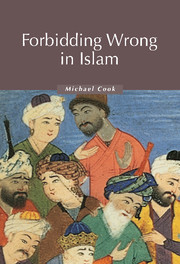Book contents
- Frontmatter
- Contents
- Preface
- Map
- 1 Introduction
- 2 The elements of the duty of forbidding wrong
- 3 How is wrong to be forbidden?
- 4 When is one unable to forbid wrong?
- 5 What about privacy?
- 6 The state as an agent of forbidding wrong
- 7 The state as an agent of wrongdoing
- 8 Is anyone against forbidding wrong?
- 9 What was forbidding wrong like in practice?
- 10 What has changed for the Sunnīs in modern times?
- 11 What has changed for the Imāmīs in modern times?
- 12 Do non-Islamic cultures have similar values?
- 13 Do we have a similar value?
- Index
9 - What was forbidding wrong like in practice?
Published online by Cambridge University Press: 05 June 2012
- Frontmatter
- Contents
- Preface
- Map
- 1 Introduction
- 2 The elements of the duty of forbidding wrong
- 3 How is wrong to be forbidden?
- 4 When is one unable to forbid wrong?
- 5 What about privacy?
- 6 The state as an agent of forbidding wrong
- 7 The state as an agent of wrongdoing
- 8 Is anyone against forbidding wrong?
- 9 What was forbidding wrong like in practice?
- 10 What has changed for the Sunnīs in modern times?
- 11 What has changed for the Imāmīs in modern times?
- 12 Do non-Islamic cultures have similar values?
- 13 Do we have a similar value?
- Index
Summary
At the end of all this analysis of the doctrines of the scholars, it is natural to ask what forbidding wrong was really like in the pre-modern Islamic world. But in attempting to answer this question, we are almost entirely at the mercy of the same scholars. They are not just the guardians of doctrine; they are also the authors of the biographical works that give us most of our material for the study of the practice of the duty. We have no journalists, anthropologists, novelists or secularists to give us different perspectives. We thus have almost no way to emancipate ourselves from the world-view of the scholars, short of not believing a word they say. With rare exceptions, the best we can do is to use common sense to discount some of what they tell us, and occasional cunning to go behind it. This chapter will accordingly describe the practice of forbidding wrong pretty much as the scholars saw it.
As already indicated, one of the best sources for this enterprise is biographical literature. The Muslim scholars devoted biographical works to such groups as poets, grammarians, Koran reciters, and even women – but above all to their fellow scholars. Before modern times the idea does not seem to have occurred to anyone to collect into a single work biographical material on those who forbade wrong. But the broad range of biographical literature contains much scattered evidence of the practice of forbidding wrong by individual Muslims.
- Type
- Chapter
- Information
- Forbidding Wrong in IslamAn Introduction, pp. 97 - 110Publisher: Cambridge University PressPrint publication year: 2003



